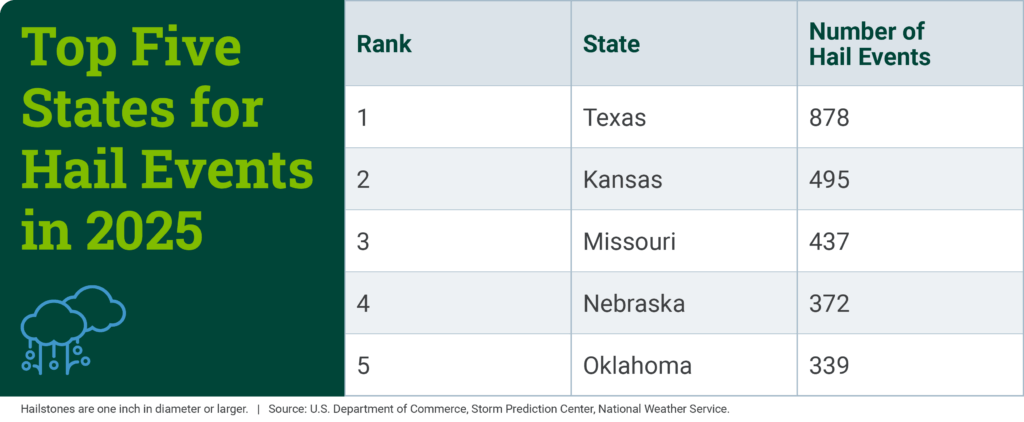
Hail Damage Roof Risks: What Homeowners Need to Know
April 15, 2025 — Disaster insights | Homeowner insights | Insurance insights
Hailstorms, though often predictable, are a frequent and destructive result of convective storms, which are a type of severe thunderstorm. These storms, known for their heavy rain, lightning, and thunder, also bring damaging winds over 58 miles per hour, large hail (an inch in diameter or more), and even tornadoes.
According to Munich Re, convective storms are among the most damaging natural disasters in the United States, both in terms of frequency and economic impact. As populations in storm-prone areas grow, property values climb, and severe weather events increase, economic losses from convective storms have surged by 90% from 2022 to 2023.
Unlike hurricanes and tornadoes, hail can be challenging to predict, but with the right precautions, like seeking shelter indoors and away from windows, you can protect yourself from a hailstorm. However, the potential for hail damage to your roof and property is harder to avoid.
Homeowners insurance claims for hail damage are among the leading cause of natural hazard-related losses, with the average claim for hail damage over the past decade reaching $9,000, according to CoreLogic.
While hailstorms are most common in the spring, summer, and fall, and especially in the central and southern plains, they can strike anywhere across the country. Aside from your homeowners insurance, home maintenance steps and loss mitigation measures are your best protection against costly effects of roof hail damage.
HOW DO I KNOW IF HAIL IS COMING?
When severe thunderstorms are in the forecast, hail is possible. According to the National Weather Service, severe thunderstorms can produce wind gusts up to 58 mph and hail 1 inch in diameter. Monitoring the weather forecast in your area for early warnings and alerts can help you prepare for severe weather. As soon as a thunderstorm warning is issued, take appropriate shelter. If it’s safe to do so, move vehicles into garages and carports, and provide protection for your pets.
WHERE ARE HAIL STORMS MOST COMMON?
In 2021, there were 3,762 major hailstorms, according to NOAA’s Severe Storm database. Hailstorms can occur anywhere in the country, but certain areas are more susceptible to experiencing hail-producing thunderstorms, specifically the Central Plains and Midwest from Texas to the Dakotas. Texas, Kansas, Nebraska, South Dakota, and Oklahoma were the top five states by number of hail events in 2021.

DOES HOMEOWNERS INSURANCE COVER HAIL CLAIMS?
Without much warning that hail is possible, your best protection is homeowners insurance coverage that safeguards against hailstorm damage. A standard homeowners policy will help cover the repair cost for hail damage up to your coverage limits. Remember, you’ll have to pay your deductible before receiving a claim payment, and with some policies, hail claims are subject to a separate, higher deductible. In cases where roof damage from the hail is less than your deductible, you wouldn’t want to file a claim.
Roofs
Hail most commonly damages a home’s roof. Homeowners policies often only cover roof damage from hail at the actual cash value (ACV) of your roof or the current value of your roof, not the current cost for repair or replacement. Adding roof replacement cost coverage to your policy will ensure that your roof can be repaired or replaced at today’s cost, not its depreciated value over time.
Siding
If your siding is damaged in a hailstorm, standard coverage will only replace the portions of the siding affected by the storm. Adding matching siding coverage to your policy allows you to replace your entire home’s siding if the new siding for the affected areas does not match the current siding, or if a reasonable replacement is unavailable.
Other Structures
Sheds, fences, and other detached structures are also covered for hail damage under a standard policy. If your property has a pool or other large building, it will need to be accounted for in your other structures coverage to ensure coverage for hail damage.
HOW CAN I PROTECT MY HOME FROM HAIL DAMAGE?
Once your homeowners insurance is in place, and you’ve confirmed your coverages and added any other coverages, the most important thing to do is to keep up with regular home maintenance.
Hail Damage–Roof
Your roof is your home’s first line of defense against Mother Nature. Consistently assessing your roof and repairing any areas with regular wear and tear will ensure that it’s in its best shape to take on a hailstorm. If you live in hail-prone areas, consider upgrading to impact-resistant shingles. The Insurance Institute for Business and Home Safety provides a comprehensive list of impact-resistant shingles.
Hail Damage–Landscaping
Yard maintenance is another step in protecting your home from storm damage. During severe thunderstorms that cause hail and high winds, your trees can become a problem for your home’s exterior. Pruning trees and removing any dead limbs or those that might scrape against your siding and roof, or break loose and damage your structure, can limit the damaging effects of a storm.
HOW DO I KNOW IF I HAVE HAIL DAMAGE ON MY ROOF?
Depending on the severity of the storm and the size of the hail, roof damage from hail can be obvious or difficult to detect. If you suspect hail damage on your roof, the best thing you can do is work with a roofing professional who can evaluate the damage. Your roofer will be looking for damage that is without a pattern, spots that are black in color, loss of granules or exposed felt and soft spots on asphalt or composite shingles. Wood shingles exhibit splits, sharp corners or impact marks as signs of hail damage. Shingles can experience damage for other reasons, like exposure to the elements, normal wear and tear, and manufacturing defects. Regular roof maintenance will provide a baseline of your roof health and help determine if hail is the cause of damage.
If widespread storms have impacted your area, be on the alert. Dishonest contractors sometimes look to take advantage of the situation. If you’re looking to assess or repair hailstorm damage to your roof or home, don’t engage with a contractor soliciting door-to-door for work, and when selecting a roofing contractor, confirm their credentials and ask for referrals.
HAIL DAMAGE REPAIR COSTS
Hail damage to a roof can be costly. According to Angie’s List, a hailstorm can result in roof damage that requires anything from replacing a few broken hail damaged shingles to completely replacing the roof. On average in the United States, hail damage repair prices for roofs cost around $4,250, but the price can range from as low as $375 to as high as $7,500, depending on your roof material, location, and the severity of the damage.
Factors such as the size of your roof, the type of roofing material, and where the damage occurred will affect your cost for repairing hail damage to your roof. Additionally, local labor rates and inspection fees will play a role in determining the final price.
HAIL DAMAGE ON ROOF: HOW DO I FILE A CLAIM?
Filing a claim for hail damage on your roof, or any other part of your house, is the same as reporting claim damage caused by other perils. The first thing you need to do is contact your insurance carrier and notify them of your loss. You’ll be assigned an adjuster and begin the process of documenting the damage and working through the claims process together.
Hail can strike unexpectedly. Selecting the right homeowners insurance coverage for your home and performing regular roof maintenance are the best ways to protect your most valuable asset. If a hailstorm causes damage to your home, taking care to identify the damage and report the claim will result in quicker repairs and prevent further loss, so you can get on with living.
- corelogic.com/wp-content/uploads/sites/4/downloadable-docs/1-hlrsk-0920-00-corelogic-hailrisk-screen-092320.pdf
- https://www.spc.noaa.gov/climo/online/monthly/2021_annual_summary.html
